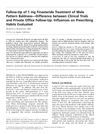Isolated Depressive Disorders and Suicidality With Finasteride Use for Androgenetic Alopecia: A Call for Enhanced Vigilance
September 2025
in “
Therapies
”
TLDR Finasteride use for hair loss may cause depression and suicidal thoughts, requiring careful monitoring.
This study analyzed 40 cases of depressive disorders and suicidality in men using finasteride 1 mg/day for androgenetic alopecia, without associated sexual dysfunction. The median age was 31, and 62.5% of cases were serious. Symptoms typically appeared within 9 months of starting treatment, with suicidality present in 40% of cases. Discontinuation led to symptom improvement in 45.2% of cases, but unresolved symptoms persisted for a median of 20.2 months post-withdrawal. Only 22.5% had a psychiatric history, and 17.5% experienced significant quality of life impacts. The study emphasizes the need for psychiatric evaluation and suicide risk assessment during treatment, given the potential for severe depressive effects and prolonged symptom persistence.



